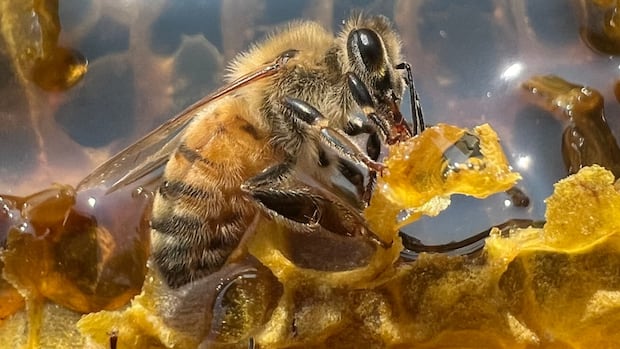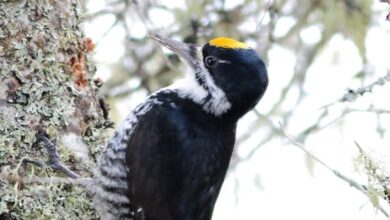Millions of bats have died from this disease. Now it’s been found in Alberta

White-nose syndrome, a deadly disease in bats, has spread to Alberta — two years after the fungus that causes it was first detected in the province.
In an update published this month, the Alberta government said white-nose syndrome had been found in two little brown bats that were sampled and released near Dinosaur Provincial Park, 225 kilometres southeast of Calgary.
Dayna Goldsmith, Alberta regional director of the Canadian Wildlife Health Cooperative, said the disease has now been confirmed in a total of three live bats that were sampled in early May.
The bats tested positive for the fungus that causes white-nose syndrome, and there were microscopic lesions in the wings associated with fungus damage, Goldsmith said.
Biologists consider white-nose syndrome one of the worst wildlife diseases in modern times in North America.
“Throughout Canada and North America, we’ve lost millions of bats to white-nose syndrome so far,” Goldsmith said.
“For a long time I’ve been expecting [white-nose syndrome] to reach Alberta. It’s definitely pretty sad that it’s here now.”
A foreign fungus
The disease is caused by a fungus, Pseudogymnoascus destructans, that was first detected in bat droppings in southeastern Alberta in spring 2022.
The fungus thrives in cool, damp conditions that mirror the ones bats seek for hibernation. Many species of bats hibernate in caves and deep rock-crevices.
Research indicates the fungus that causes white-nose syndrome likely arrived from Europe through shipping or cave exploration. The disease was discovered in New York state in 2006, and it’s now in every province in Canada, except for British Columbia.
“We anticipate the fungus and the disease will spread north and west, and affect a number of bat species,” the province said in its online update.
Since hibernating bats huddle closely together in large groups for long periods of time, the fungus can pass along easily.
“In some situations, all the bats in individual caves die during the winter months,” the update said.
Pollinating bats and long-distance migrants that don’t hibernate don’t seem to be affected by white-nose syndrome.
When an infected bat lowers its body temperature during hibernation, the cold-loving fungus starts to invade and ingest their skin. This can look like white fuzz appearing on the bat’s muzzle, ears and wings, hence the name, white-nose syndrome.
It causes bats to wake up more frequently during the winter. Since there are no food sources available, they use up their limited fat sources very quickly. Destruction of wing tissue also disrupts the bats’ water and electrolyte balance.
“They basically starve to death,” said Jordi Segers, national white-nose syndrome scientific program co-ordinator with the Canadian Wildlife Health Cooperative.
The fungus itself isn’t dangerous. It’s only considered white-nose syndrome once it’s able to grow and reproduce on a bat.
The fungus lies dormant on a bat’s skin when it is awake and active. The fungus can only grow in conditions between 5 C and 20 C. During hibernation a bat will lower its body temperature by anywhere between four and 14 degrees.
When the fungus is detected in soil or in a cave, it doesn’t indicate the presence of the disease itself.
Bats are hidden helpers
Bats are often depicted in popular culture as frightening creatures that sometimes end up roosting in your attic.
It can be easy to forget their importance. They are the major nighttime predator of mosquitoes and other flying insects. A bat can eat its body weight in bugs during a single night’s hunt.
Bats support unique cave ecosystems and act as natural pest control by eating insects that destroy crops. Segers said studies in North America have found that bats are responsible for saving billions of dollars in agricultural losses every year.
“They’re providing tremendous value to our communities and to our ecosystems, but they mainly go unnoticed,” said Cory Olson, who co-ordinates the Alberta bat program for the Wildlife Conservation Society Canada.
What can we do to help?
Albertans can support and protect bats in multiple ways.
Anyone planning to visit a cave should be well-informed on decontamination protocols. Fungus spores can survive for a long time on clothes, shoes and equipment. There’s a risk that these spores can be transferred to new places where bats hibernate.
In Alberta, it’s illegal to enter a cave where bats are hibernating between Sept. 1 and April 30.
The provincial government also recommends that people maintain places for bats to roost, hibernate and forage.
Olson said if you have a bat on your property, it’s important not to disturb them when its raising its pup. In the fall, bats will usually leave on their own.
“To kick them out in the middle of the summer is going to cause mortality of their pups, and we don’t want that,” he said.
“For bats that are able to withstand white-nose syndrome, we want to ensure that they can survive and successfully reproduce.”
There is currently no cure or treatment available for white-nose syndrome.
Olson said WCS Canada, in partnerships with the Alberta government, universities, and other organizations, is working on developing a probiotic cocktail that could give bats improved resistance to the fungus.
“The next steps are continuing to monitor to see if the same level of die-off that occurred in eastern North America is also going to occur in Alberta,” Olson said.
“It’s possible that our bats could be more resistant. It may be wishful thinking at this point.”




